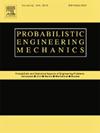Augmented weighted low-discrepancy simulation with hyper-spherical ring for general reliability analysis
IF 3
3区 工程技术
Q2 ENGINEERING, MECHANICAL
引用次数: 0
Abstract
Due to the increasing complexity of modern engineering systems, conventional reliability methods encounter significant challenges in dealing with high-dimensional stochastic problems. This study presents a hyper-spherical ring-augmented weighted low-discrepancy simulation (HSR-WLDS) method, which expands the applicability of original WLDS to high-dimensional reliability problems. Inspired from the geometric insights observed in the independent standard normal space, the proposed method innovatively integrates the well-established WLDS with a hyper-spherical transformation. This strategy leverages the rotational symmetry inherent in the joint probability density function (PDF), ensuring that the sample weights are solely dependent on the radius, thereby effectively mitigating the impact of extreme weights in high-dimensional spaces. Furthermore, by utilizing the important ring to concentrate computational efforts on critical areas, this method effectively mitigates computational complexity and enhances efficiency for estimating failure probabilities. The performance of the proposed method is verified through four numerical examples, encompassing highly nonlinear limit state function (LSF), multiple failure modes, and both component and system high-dimensional problems, as well as an engineering slope stability example. The results demonstrate the robustness and effectiveness of the proposed method, highlighting its superiority in high-dimensional reliability problems with improved computational efficiency.
用于一般可靠性分析的超球面环增强加权低差仿真
由于现代工程系统日益复杂,传统的可靠性方法在处理高维随机问题时遇到了重大挑战。提出了一种超球面增环加权低差仿真方法,扩展了原有增环加权低差仿真方法在高维可靠性问题中的适用性。该方法从独立标准正态空间中观察到的几何见解中得到启发,创新地将成熟的WLDS与超球面变换相结合。该策略利用了联合概率密度函数(PDF)固有的旋转对称性,确保样本权重仅依赖于半径,从而有效地减轻了高维空间中极端权重的影响。此外,该方法利用重要环将计算精力集中在关键区域,有效地降低了计算复杂度,提高了故障概率估计的效率。通过包含高度非线性极限状态函数(LSF)、多种破坏模式、构件和系统高维问题的四个数值算例,以及工程边坡稳定算例,验证了所提出方法的有效性。结果表明了该方法的鲁棒性和有效性,突出了其在高维可靠性问题中的优势,提高了计算效率。
本文章由计算机程序翻译,如有差异,请以英文原文为准。
求助全文
约1分钟内获得全文
求助全文
来源期刊

Probabilistic Engineering Mechanics
工程技术-工程:机械
CiteScore
3.80
自引率
15.40%
发文量
98
审稿时长
13.5 months
期刊介绍:
This journal provides a forum for scholarly work dealing primarily with probabilistic and statistical approaches to contemporary solid/structural and fluid mechanics problems encountered in diverse technical disciplines such as aerospace, civil, marine, mechanical, and nuclear engineering. The journal aims to maintain a healthy balance between general solution techniques and problem-specific results, encouraging a fruitful exchange of ideas among disparate engineering specialities.
 求助内容:
求助内容: 应助结果提醒方式:
应助结果提醒方式:


